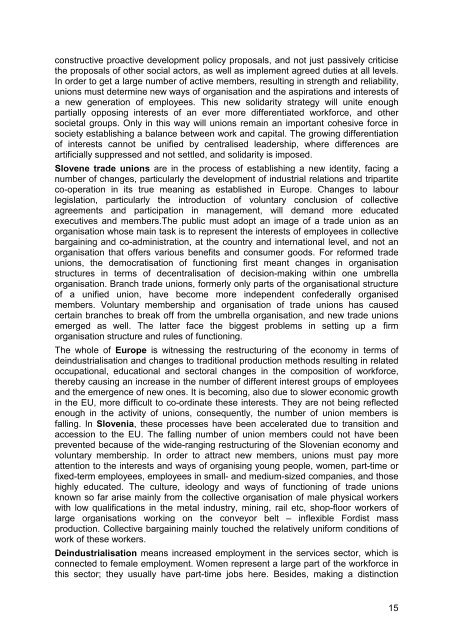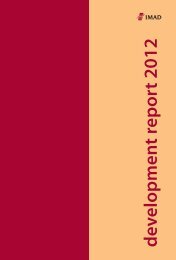The Development of New Industrial Relations in Slovenia - UMAR
The Development of New Industrial Relations in Slovenia - UMAR
The Development of New Industrial Relations in Slovenia - UMAR
You also want an ePaper? Increase the reach of your titles
YUMPU automatically turns print PDFs into web optimized ePapers that Google loves.
constructive proactive development policy proposals, and not just passively criticise<br />
the proposals <strong>of</strong> other social actors, as well as implement agreed duties at all levels.<br />
In order to get a large number <strong>of</strong> active members, result<strong>in</strong>g <strong>in</strong> strength and reliability,<br />
unions must determ<strong>in</strong>e new ways <strong>of</strong> organisation and the aspirations and <strong>in</strong>terests <strong>of</strong><br />
a new generation <strong>of</strong> employees. This new solidarity strategy will unite enough<br />
partially oppos<strong>in</strong>g <strong>in</strong>terests <strong>of</strong> an ever more differentiated workforce, and other<br />
societal groups. Only <strong>in</strong> this way will unions rema<strong>in</strong> an important cohesive force <strong>in</strong><br />
society establish<strong>in</strong>g a balance between work and capital. <strong>The</strong> grow<strong>in</strong>g differentiation<br />
<strong>of</strong> <strong>in</strong>terests cannot be unified by centralised leadership, where differences are<br />
artificially suppressed and not settled, and solidarity is imposed.<br />
Slovene trade unions are <strong>in</strong> the process <strong>of</strong> establish<strong>in</strong>g a new identity, fac<strong>in</strong>g a<br />
number <strong>of</strong> changes, particularly the development <strong>of</strong> <strong>in</strong>dustrial relations and tripartite<br />
co-operation <strong>in</strong> its true mean<strong>in</strong>g as established <strong>in</strong> Europe. Changes to labour<br />
legislation, particularly the <strong>in</strong>troduction <strong>of</strong> voluntary conclusion <strong>of</strong> collective<br />
agreements and participation <strong>in</strong> management, will demand more educated<br />
executives and members.<strong>The</strong> public must adopt an image <strong>of</strong> a trade union as an<br />
organisation whose ma<strong>in</strong> task is to represent the <strong>in</strong>terests <strong>of</strong> employees <strong>in</strong> collective<br />
barga<strong>in</strong><strong>in</strong>g and co-adm<strong>in</strong>istration, at the country and <strong>in</strong>ternational level, and not an<br />
organisation that <strong>of</strong>fers various benefits and consumer goods. For reformed trade<br />
unions, the democratisation <strong>of</strong> function<strong>in</strong>g first meant changes <strong>in</strong> organisation<br />
structures <strong>in</strong> terms <strong>of</strong> decentralisation <strong>of</strong> decision-mak<strong>in</strong>g with<strong>in</strong> one umbrella<br />
organisation. Branch trade unions, formerly only parts <strong>of</strong> the organisational structure<br />
<strong>of</strong> a unified union, have become more <strong>in</strong>dependent confederally organised<br />
members. Voluntary membership and organisation <strong>of</strong> trade unions has caused<br />
certa<strong>in</strong> branches to break <strong>of</strong>f from the umbrella organisation, and new trade unions<br />
emerged as well. <strong>The</strong> latter face the biggest problems <strong>in</strong> sett<strong>in</strong>g up a firm<br />
organisation structure and rules <strong>of</strong> function<strong>in</strong>g.<br />
<strong>The</strong> whole <strong>of</strong> Europe is witness<strong>in</strong>g the restructur<strong>in</strong>g <strong>of</strong> the economy <strong>in</strong> terms <strong>of</strong><br />
de<strong>in</strong>dustrialisation and changes to traditional production methods result<strong>in</strong>g <strong>in</strong> related<br />
occupational, educational and sectoral changes <strong>in</strong> the composition <strong>of</strong> workforce,<br />
thereby caus<strong>in</strong>g an <strong>in</strong>crease <strong>in</strong> the number <strong>of</strong> different <strong>in</strong>terest groups <strong>of</strong> employees<br />
and the emergence <strong>of</strong> new ones. It is becom<strong>in</strong>g, also due to slower economic growth<br />
<strong>in</strong> the EU, more difficult to co-ord<strong>in</strong>ate these <strong>in</strong>terests. <strong>The</strong>y are not be<strong>in</strong>g reflected<br />
enough <strong>in</strong> the activity <strong>of</strong> unions, consequently, the number <strong>of</strong> union members is<br />
fall<strong>in</strong>g. In <strong>Slovenia</strong>, these processes have been accelerated due to transition and<br />
accession to the EU. <strong>The</strong> fall<strong>in</strong>g number <strong>of</strong> union members could not have been<br />
prevented because <strong>of</strong> the wide-rang<strong>in</strong>g restructur<strong>in</strong>g <strong>of</strong> the <strong>Slovenia</strong>n economy and<br />
voluntary membership. In order to attract new members, unions must pay more<br />
attention to the <strong>in</strong>terests and ways <strong>of</strong> organis<strong>in</strong>g young people, women, part-time or<br />
fixed-term employees, employees <strong>in</strong> small- and medium-sized companies, and those<br />
highly educated. <strong>The</strong> culture, ideology and ways <strong>of</strong> function<strong>in</strong>g <strong>of</strong> trade unions<br />
known so far arise ma<strong>in</strong>ly from the collective organisation <strong>of</strong> male physical workers<br />
with low qualifications <strong>in</strong> the metal <strong>in</strong>dustry, m<strong>in</strong><strong>in</strong>g, rail etc, shop-floor workers <strong>of</strong><br />
large organisations work<strong>in</strong>g on the conveyor belt – <strong>in</strong>flexible Fordist mass<br />
production. Collective barga<strong>in</strong><strong>in</strong>g ma<strong>in</strong>ly touched the relatively uniform conditions <strong>of</strong><br />
work <strong>of</strong> these workers.<br />
De<strong>in</strong>dustrialisation means <strong>in</strong>creased employment <strong>in</strong> the services sector, which is<br />
connected to female employment. Women represent a large part <strong>of</strong> the workforce <strong>in</strong><br />
this sector; they usually have part-time jobs here. Besides, mak<strong>in</strong>g a dist<strong>in</strong>ction<br />
15
















